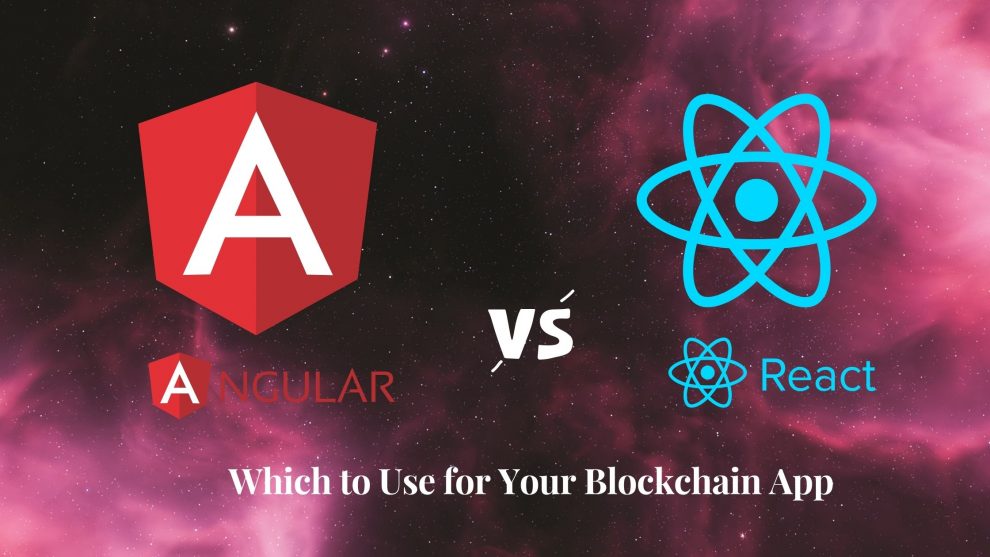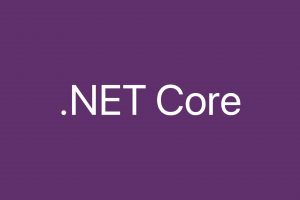Blockchain technology has revolutionized various industries, offering decentralized, secure, and transparent solutions. As the popularity of blockchain continues to soar, developers face the crucial decision of choosing the right framework for building robust applications atop this innovative technology. Among the top contenders in the realm of frontend development are Angular and React. Let’s explore the strengths of each and determine which might suit your blockchain app better.
Angular: The Robust, Comprehensive Framework
Angular, developed and maintained by Google, stands out as a comprehensive framework providing a structured environment for building large-scale applications. Here are some of its key features
Two-Way Data Binding:
Angular’s two-way data binding allows for seamless synchronization between the model and the view, simplifying development and enhancing productivity when handling blockchain data.Full-Fledged Framework:
Angular offers a comprehensive framework with built-in functionalities like dependency injection, routing, and form handling. This feature-rich environment is advantageous for building complex blockchain applications.TypeScript Integration:
Angular leverages TypeScript by default, ensuring a statically typed environment. This integration enhances code quality, improves maintainability, and aids in identifying errors during development, crucial for blockchain projects.Directives and NgModules:
Angular provides directives for extending HTML and NgModules for modular architecture, promoting code organization and maintainability within blockchain apps.CLI for Streamlined Development:
Angular’s Command Line Interface (CLI) simplifies development tasks, providing commands for generating components, services, and modules. This streamlines the workflow and enhances productivity, especially in blockchain projects.
React: The Flexible, Component-Based Library
React, maintained by Facebook, has gained immense popularity for its component-based architecture and flexibility. Here are some reasons why React might be the right fit for your blockchain application
Component-Based Architecture:
React.js revolves around a component-based approach, breaking down the user interface into reusable and encapsulated components. This modularity fosters easier development, maintenance, and scalability of blockchain apps.Virtual DOM:
React utilizes a virtual DOM, optimizing performance by efficiently updating the DOM elements. This results in improved speed and responsiveness, crucial for handling data-intensive operations in blockchain applications.JSX for Enhanced UI:
JSX, a syntax extension in React, allows the mixing of JavaScript with HTML. This feature facilitates the creation of dynamic and interactive user interfaces, a desirable trait for blockchain apps seeking an engaging user experience.One-Way Data Binding:
React primarily implements one-way data binding, simplifying the flow of data and ensuring predictable behavior within components. This unidirectional data flow aids in debugging and maintaining the application’s state.Rich Ecosystem and Community Support:
React boasts a vast ecosystem with numerous libraries, tools, and community support, providing developers with ample resources and solutions while working on blockchain projects.
Related: Advanced React.js Concepts in 2024
React.js vs Angular: Key Differences
1. Architecture
React (Component-Based):
React adopts a component-based architecture where the UI is divided into reusable components. This modular structure promotes code reusability, making it easier to maintain and scale blockchain applications by isolating functionality within components.Angular (Modular):
Angular employs a modular architecture facilitated by NgModules. It allows organizing the application into cohesive modules, containing components, services, directives, and more. This modularity enhances maintainability and facilitates collaboration among developers working on different sections of a blockchain app.
2. Data Binding
React (One-Way):
React primarily employs one-way data binding, meaning the flow of data occurs in a single direction, from the parent components to their children. This simplicity aids in maintaining the application’s state and improves performance in blockchain apps with complex data interactions.Angular (Two-Way):
Angular utilizes two-way data binding, enabling automatic synchronization between the model and the view. This bidirectional data flow simplifies real-time data handling in blockchain applications, ensuring immediate updates to the UI when the model changes.
3. Language
React (JSX):
React utilizes JSX, a JavaScript extension that allows developers to write HTML-like syntax within JavaScript. JSX simplifies the creation of dynamic and interactive user interfaces for blockchain apps, enhancing readability and enabling easier component composition.Angular (TypeScript):
Angular is built with TypeScript, a superset of JavaScript that provides optional static typing. TypeScript enhances code maintainability, readability, and scalability in larger blockchain projects by identifying errors during development and enabling better code structuring.
4. Ecosystem
React (Rich Ecosystem):
React boasts a rich ecosystem with a vast collection of libraries, tools, and community-contributed resources. This extensive ecosystem empowers developers to leverage various third-party solutions, enhancing development speed and flexibility in building blockchain applications.Angular (Comprehensive Ecosystem):
Angular provides a comprehensive ecosystem with built-in tools, powerful functionalities, and a well-documented framework. Its ecosystem offers an all-inclusive package, reducing the need for external dependencies and ensuring a standardized approach to blockchain app development.
5. Performance
React (Virtual DOM):
React utilizes a virtual DOM, a lightweight representation of the actual DOM. This approach minimizes DOM manipulation, optimizing rendering and enhancing the performance of blockchain applications handling vast amounts of data by efficiently updating only the necessary components.Angular (Two-Way Data Binding):
Angular’s two-way data binding enables real-time synchronization between the model and the view. While beneficial for real-time applications, especially in blockchain scenarios requiring immediate updates, it may impact performance in highly complex apps due to its continuous synchronization process.
6. Community Support and Adoption
React:
React has gained immense popularity and has a large and active community, resulting in extensive support, frequent updates, and a vast array of resources and tutorials available for developers.Angular:
Angular also enjoys a strong community support base, with backing from Google, ensuring consistent updates, robust documentation, and enterprise-grade solutions, making it suitable for large-scale blockchain projects requiring long-term support.
7. Learning Curve
React:
React’s learning curve is often considered more straightforward, especially for developers familiar with JavaScript, making it easier for new developers to get started with building blockchain applications.Angular:
Angular’s comprehensive nature may lead to a steeper learning curve, particularly for beginners, due to its extensive tooling and the concepts involved. However, once mastered, it offers a more structured approach to development.
8. Tooling and Development Environment
React:
React provides minimal tooling out of the box, allowing developers to choose preferred libraries and tools, providing flexibility in the development environment setup for blockchain applications.Angular:
Angular’s CLI (Command Line Interface) offers a robust set of tools and commands, streamlining the development process by providing standardized procedures and best practices for building blockchain apps.
9. Flexibility and Adaptability
React:
React’s component-based structure offers greater flexibility, allowing developers to adopt their preferred architecture patterns and integrate with other libraries more seamlessly in blockchain development.Angular:
Angular’s opinionated framework may be less flexible in certain aspects but provides a more structured approach, ensuring consistency and standardization across large blockchain projects.
10. Size and Performance Impact
React:
Being more lightweight, React’s library size is smaller compared to Angular. This smaller footprint can lead to faster initial load times and better performance in certain scenarios for blockchain applications.Angular:
Angular’s comprehensive framework may result in a larger initial bundle size. While this might impact the initial load time, Angular’s performance optimizations can make it suitable for handling more complex blockchain applications in the long run.
Framework Comparison: React.js vs Angular in tabular form
| Key Differences | React.js | Angular |
|---|---|---|
| Architecture | Component-Based | Modular |
| Data Binding | One-Way | Two-Way |
| Language | JSX (JavaScript Extension) | TypeScript |
| Ecosystem | Rich | Comprehensive |
| Performance | Virtual DOM | Two-Way Data Binding |
| Community Support | Large and Active Community | Strong Google-backed Community |
| Learning Curve | Relatively Straightforward | Steeper Learning Curve |
| Tooling & Dev. Env. | Minimal Tooling, Flexible Setup | CLI for Standardized Development |
| Flexibility | Component Flexibility, Integration with Libraries | Opinionated Framework |
| Size & Performance | Smaller Library Size, Potential Faster Load Times | Larger Initial Bundle Size, Performance Optimizations |
Read More: Node.js and Next.js: Evolution in Backend Development
Choosing the Right Framework for Your Blockchain App
When it comes to building blockchain applications, both Angular and React offer distinctive advantages. The choice ultimately depends on the specific requirements of your project
Complexity and Scalability:
For large-scale, enterprise-grade blockchain applications requiring comprehensive features and tooling, Angular’s robustness and built-in functionalities might be beneficial.Flexibility and Performance:
If your focus is on building a highly responsive, interactive interface for your blockchain app while ensuring scalability, React’s component-based architecture and virtual DOM could be advantageous.Development Team Expertise:
Consider the expertise and familiarity of your development team with either framework. A team comfortable with Angular might deliver faster results using that framework, while a team experienced in React might prefer its flexibility.Community and Support:
Assess the community backing and support available for each framework. React and Angular both have active communities, but the size, accessibility of resources, and availability of third-party libraries could influence your decision. A more extensive community might offer quicker issue resolution and a broader knowledge base.Long-term Maintenance and Updates:
Consider the long-term maintenance requirements of your blockchain app. Evaluate each framework’s track record for backward compatibility, version updates, and support lifecycle. A framework with consistent updates and long-term support can ensure the longevity and security of your application.Project Timeline and Deadlines:
Analyze your project’s timeline and deadlines. React’s flexibility might expedite initial development due to its simpler learning curve, while Angular’s comprehensive structure might offer more streamlined development once the team is proficient. Choose a framework aligned with your project’s timeline without compromising quality.Integration and Compatibility:
Examine the compatibility and integration aspects with other technologies and libraries. Determine if the chosen framework aligns well with the existing tech stack or blockchain protocols your app will interact with. Compatibility issues could impact development speed and future enhancements.Scalability and Future Expansion:
Consider the scalability potential and ease of future expansion for your blockchain app. Evaluate how well each framework accommodates growing needs, additional features, and scalability requirements specific to your project’s roadmap and potential future integrations.Documentation and Learning Resources:
Review the quality and comprehensiveness of the documentation and learning resources available for each framework. A well-documented framework with ample tutorials, guides, and official documentation can significantly ease the learning curve for new team members and expedite development.Cost Considerations:
While both React and Angular are open-source frameworks, consider any associated costs such as training, third-party tooling, or enterprise support if necessary. Assess the overall cost of ownership, including any additional tools or resources required for efficient development and maintenance.
Conclusion
In conclusion, both Angular and React have their strengths and are capable of delivering powerful blockchain applications. Assessing your project’s specific needs, considering the expertise of your team, and evaluating the scalability requirements will guide you toward making an informed decision.
Ultimately, whether you opt for Angular or React, building a successful blockchain application depends on leveraging the strengths of the chosen framework while aligning with the core principles of blockchain technology – security, transparency, and decentralization.
Choose wisely, harness the potential of the framework you select, and embark on creating the next generation of innovative blockchain applications!



























Add Comment